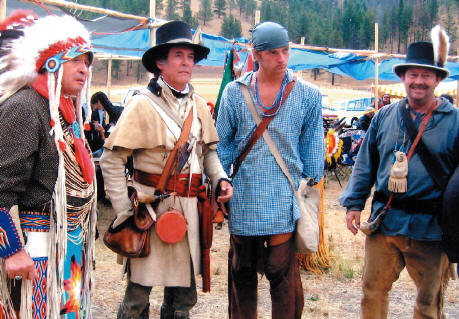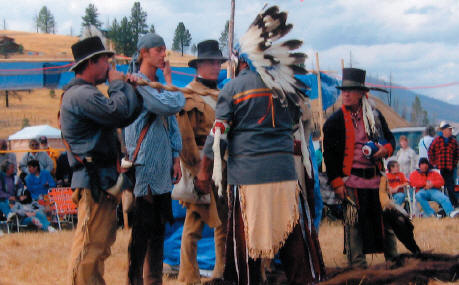Christian Living Stories: Making History in Montana
During 2006, the United States will continue to celebrate the bicentennial of the epic journey of exploration by Lewis and Clark. The two explorers, accompanied by a handpicked Corps of Discovery, explored the hitherto unknown Northwest. In September 1805, Lewis and Clark met with the Salish Indians near what is now Ross’s Hole, Montana. What was intended to reenact history became a history-making event in its own right. Mike Wallace, president of the area chapter of the Lewis and Clark Trail Heritage Foundation, tells what happened.
 |
| From left: Scotty Gardipee, descendent of one of the chiefs who met Lewis and Clark, Peyton “Bud” Clark (descendant of William Clark), Josh Loftis (descendant of Pvt. George Shannon) and Mike Wallace. |
By Mike Wallace
It was exactly 200 years ago last September when the Lewis and Clark expedition came through our neck of the woods here in Montana.
As president of the area chapter of the Lewis and Clark Trail Heritage Foundation (LCTHF), I was among those responsible for organizing the local bicentennial commemorative events. We planned a reenactment and a celebration. What happened was more than that—much more.
First, some background. Between 2004 and 2006, our nation is commemorating the unforgettable journey made by Meriwether Lewis and William Clark and their Corps of Discovery that explored the hitherto unknown northwest of our country.
Through a series of special events, many Americans are retracing this epic adventure. In September 1805, the Lewis and Clark expedition camped for several days in what is now Travelers Rest State Park, in western Montana.
After 10 years of extensive archaeological research, our chapter discovered the only scientifically verifiable campsite along the 8,000-mile trail. So, as the bicentennial date approached, we planned appropriate commemoration activities in Travelers Rest State Park at the very campsite used by the original expedition.
We were joined by members of the Discovery Expedition of St. Charles, led by Bud Clark, great-great-grandson of Captain William Clark. They set up camp beside us in the park, and we quickly melded into one large Lewis and Clark living history re-enactment brigade.
The festivities began on the morning of Thursday, Sept. 8. Hundreds of school-age children arrived by bus. Our job was to show visitors how Lewis and Clark’s corps survived on the trail. The day was hot and we were tired, but things went well.
Next day, Friday, Sept. 9, was the big day. Exactly 200 years earlier Lewis and Clark were right here in our park. A formal, awe-inspiring salute was led by “Captain Clark” and “Captain Lewis” of the Discovery Expedition from St. Charles. For one full minute we stood at attention in silence, lost in our own private thoughts on the spot where Lewis and Clark had stood 200 years before.
The Salish Powwow
That evening, several of us proceeded down the Bitterroot Valley to participate in another event at the Salish Powwow grounds three miles south of Sula, Montana. Two hundred years and six days previously, Lewis and Clark had struggled out of the Lost Trail Pass area only to run into the Salish peoples near what is now called Ross’s Hole, Montana.
Like Lewis and Clark, we camped near the Indians and not with them. We were asked by the Salish to camp about 300 yards up the hill from the circle of the powwow. It was cold and chilly. Dark clouds with spatters of rain greeted us as we set up our tents.
About 7 p.m. we went down to the powwow and were welcomed by the Salish people. Rain fell steadily as we danced with them until late into the night accompanied by their songs and the beating of their drums.
We finally retired to our camp for some much-needed rest, but down the hill the dancing and drums continued. Drum, drum, drum … drum, drum, drum. It was extremely cold, and the rain frequently alternated with sleet. By morning our tents were drenched.
At 1 p.m., the Salish powwow began again, and the elders invited us to participate with the entire tribe in a special ceremony—the sacred Snake Dance. We felt humbled to be included in such an event so meaningful for the Salish. We were being welcomed with the kindness and friendship the Salish have traditionally had for all people. Sadly, that kindness and friendship has not always been returned.
Johnnie Arlee, one of the Salish tribal elders, began to recite the story of the original meeting of Lewis and Clark with his ancestors near this spot. He explained how the lives of all Salish began to change the day the white man descended from the mountains and bartered for horses.
As he spoke, we, the modern representatives of the Corps of Discovery, came into the center of the circle of drums. Three chiefs met us. As Johnnie Arlee continued to narrate the story from the Salish perspective, the ceremony began.
 |
| Smoking the peace pipe |
The chiefs greeted us in friendship, and we returned their greeting. Then the bartering for horses began. The kinickinick (a smoking mixture made from bark) was ceremoniously removed from its pouch and lit.
Scotty Gardipee, a Salish elder, waved the smoke over us. We all sat on buffalo and elk robes as the elders lit their ceremonial pipe and we shared the pipe of peace and friendship.
At first, it was just another reenactment. But somewhere during this ceremony it ceased to be acting and became new Montana history.
Two hundred years and six days after Lewis and Clark had smoked the pipe of peace, we repeated this act. Two descendants of the original Corps of Discovery and several Salish descendants of the original Indians of 200 years ago, together again, at peace in friendship.
God asks us to be peacemakers, to seek to make peace with our neighbors (compare Matt. 5:9). We can preach the true gospel of Jesus by our positive actions to build bridges of kindness and friendship.
I was lost in the moment. What started as a reenactment became a moment of real reconciliation. When it came time to leave our Salish friends it was hard to go.
Next day was the last day of our part in last year’s bicentennial activities. Sept. 11 now has a special meaning for all Americans. But in 1805 it was just another day of the year, as Lewis, Clark and the entire Corps of Discovery headed up the mountain to the west.
May the next 200 years be more peaceful than the last. In 2205, may my great-great-great-grandchildren be part of something so rare and special.
Author: Mike Wallace
